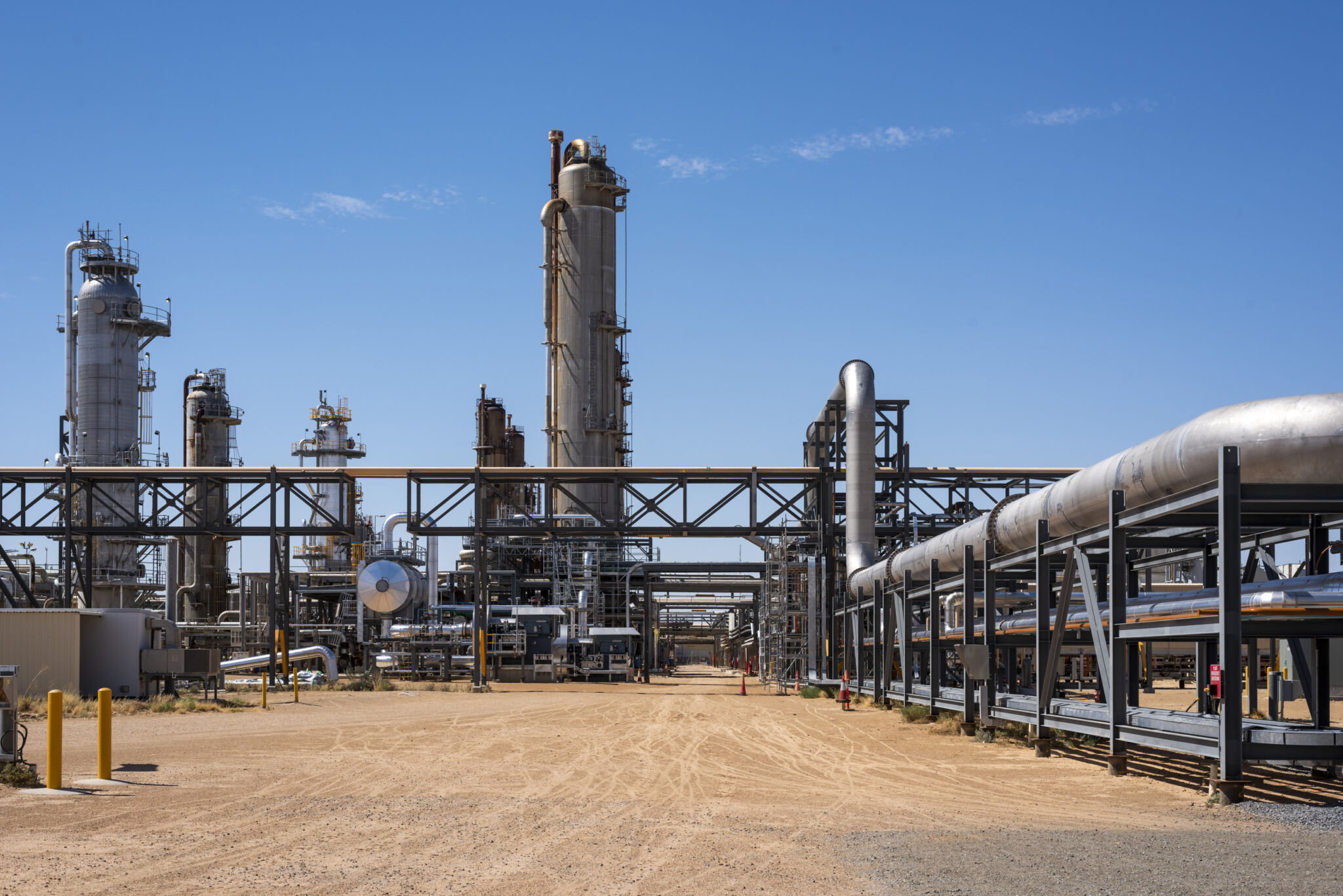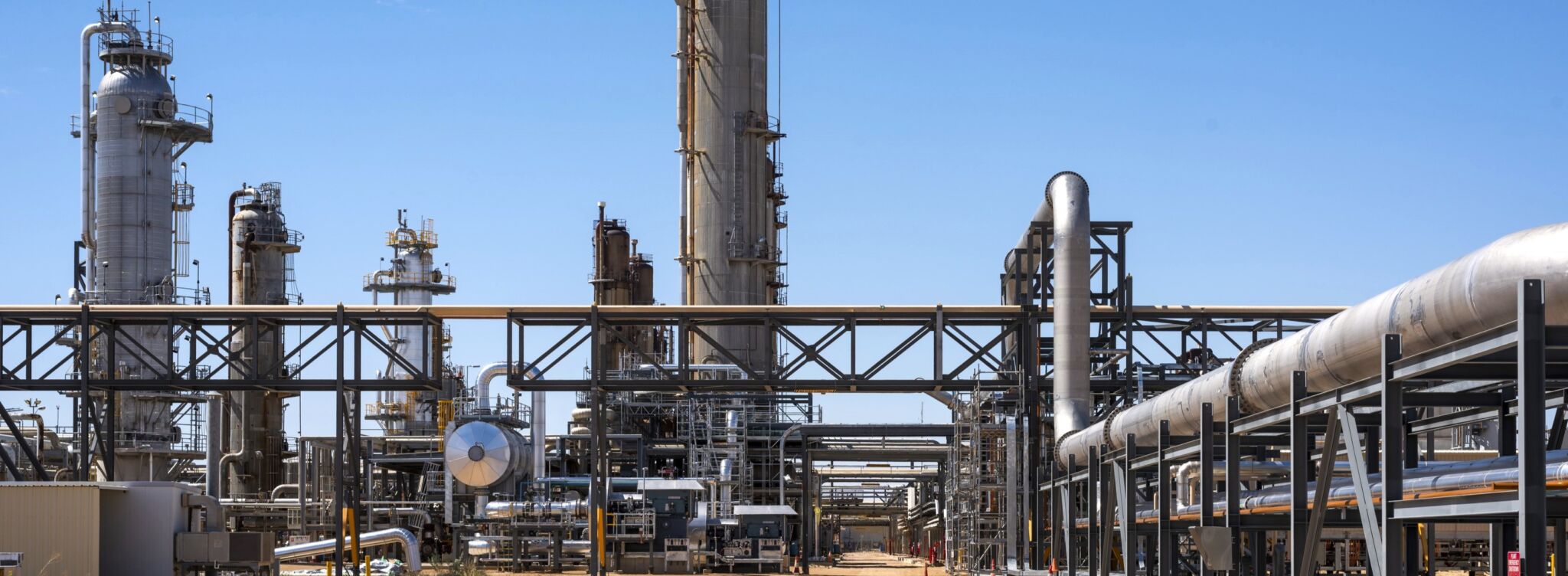Santos Midstream and Energy Solutions’ principal activities are operating midstream assets, progressing technologies, such as carbon capture and storage (CCS), that support decarbonisation of Santos and third-party products, the generation of high integrity emissions reduction units and development of low carbon fuels, as customer demand evolves.
Moomba CCS
The Moomba CCS phase 1 project is now online and storing CO2 in Cooper Basin depleted reservoirs. Technology and reservoir performance is in line with expectations. Santos injected 340,000 tonnes (gross) of carbon dioxide equivalent in 2024, with the project operating at full injection rates. Moomba CCS has outstanding growth potential depending on the availability of CO2 for storage.

Midstream infrastructure portfolio
Santos has a unique portfolio of strategic midstream infrastructure assets. The midstream division of our business involves gas processing, storage, transport and liquefaction assets. Our infrastructure assets include the below.
Northern Territory, Australia
Located at Wickham Point, Santos is operator of Darwin LNG, a single train liquefaction and storage facility that started production in 2006.
The DLNG facility received gas feedstock via a 500 kilometre pipeline from the Bayu-Undan platform in the Timor Sea. Santos is working to develop a carbon capture and storage facility at Bayu-Undan in the future once the gas field reaches end of field life.
With the capacity to produce approx. 3.7 million tonnes of LNG per annum, the DLNG Life Extension Project seeks to prepare the DLNG facility for backfill from the Barossa field, extending facility life for around 20 years.
Western Australia, Australia
Located 45 kilometres southwest of Karratha in Western Australia, Devil Creek Gas Plant commenced operations in 2011. The processing plant receives gas and condensate from the offshore, Santos-operated Reindeer field’s gas production platform.
Onshore facilities comprise a two-train gas plant, a gas supply pipeline and a sales gas export pipeline. Raw natural gas is processed at the Devil Creek Gas Plant before being supplied to the WA domestic market through the Dampier to Bunbury Natural Gas Pipeline (DBNGP).
Santos is investigating the potential to develop a carbon capture and storage (CCS) project at Reindeer and Devil Creek once Reindeer reaches end of field life.
South Australia, Australia
The Moomba Plant is the SACB JV central gathering and processing hub for oil and gas produced in the Cooper and Eromanga Basins and is operated by Santos. The joint venture has recently invested in upgrades to the Moomba plant to ensure capture of CO2 emissions from processed oil and gas. This CO2 is then transferred to the CCS joint venture currently developing the Moomba CCS project – refer to the CCS section below.
Once processed, natural gas and ethane is transported through pipelines to the east coast, supplying domestic gas and LNG export to Asia. Natural gas liquids are sent with stabilised crude oil and condensate through a 659-kilometre pipeline to Port Bonython.
South Australia, Australia
Located approximately 16 kilometres northeast of Whyalla and owned by the SACB JV, the Santos operated Port Bonython facility is comprised of a deep-water port, gas fractionation plant and a storage facility.
Following processing, Santos supplies LPG gas to the domestic market from Port Bonython, powering homes and businesses around the country.
High quality crude and naphtha products are shipped from Port Bonython into Australia and Asian energy markets for fuels and manufacturing.
Santos has installed a 2.12MW solar farm at Port Bonython providing renewable energy directly to the Port Bonython processing facility.
Offshore Western Australia, Australia
In operation since 1986, the Varanus Island offshore site is located 75 kilometres offshore northwest Australia.
Approximately 30 hectares of the island’s reserve has been leased for the operation of the oil and gas receiving, processing, loading and export facilities and associated infrastructure known as the Varanus Island Hub.
Owned and operated by Santos, gas, condensate and oil from the offshore John Brookes, Harriet and Spar-Halyard fields is piped to the facility for processing, storage and export to market.
The sales gas is then transported to mainland WA via two 100 kilometre pipelines, where it is supplied to major mining and industrial customers.
Hubs for CCS and potential low carbon fuels
At Santos, we aspire to be a leading provider of carbon capture and storage (CCS) infrastructure, carbon management services and low carbon fuels.
We have a three hub strategy around our operations in Moomba, Darwin and Bayu-Undan, and Western Australia.
Technologies like CCS and potentially direct air capture (DAC) will decarbonise our own operations, with the potential for expansion to store customer emissions.
South Australia, Australia
Santos’ Moomba hub is located in the northeast of South Australia and houses strategically important infrastructure for the transportation of natural gas, ethane and hydrocarbon liquids around the east coast of Australia.
The Moomba CCS project utilises existing infrastructure and processing capability at the Moomba Gas Plant, combined with depleted reservoirs in the Cooper Basin. Santos expects it to be one of the lowest-cost CCS projects globally with a future potential storage capacity of around 20 million tonnes of CO2 per annum.
Longer term, Santos’ strategy intends to consider the development of low carbon fuels (such as e-methane) and technologies, such as DAC, which may be scaled-up across the Cooper Basin. The Cooper Basin has a natural competitive advantage for the development of these products and services including excellent renewable energy resources, produced water, natural gas and existing pipeline connections to domestic and export markets.
Offshore Northern Territory, Australia and offshore Timor-Leste
Santos is working with both the Australian and Timor-Leste Governments with a view to progressing the Bayu-Undan CCS project.
The project has the potential to be the largest CCS project in the world, with predicted storage capacity of around 10 million tonnes of CO2 per annum, and one of the many CCS projects that will be critical to help the world meet its climate goals.
Santos’ Barossa LNG is one of several potential CO2 sources for Bayu-Undan CCS, but importantly this project offers a whole-of-region carbon solution.
Western Australia, Australia
The Reindeer CCS project has the capacity to store up to five million tonnes of CO2 per annum. The project is offering carbon management services to capture third-party emissions from customers in the area. The CO2 will be transported to the Devil Creek facility and then sent through our existing infrastructure to the Reindeer platform, where it will be stored in the depleted gas reservoir once production ceases.
Carbon solutions
Our ambitious net-zero emissions target will be supported through the use of high-quality nature-based solutions.
Santos’ climate transition action plan has portfolio-wide implications. In transforming our business to help create a better world for everyone, our plan to achieve net-zero emissions is based on the hierarchy of:
1. Avoid: Transform our base energy business to supply critical fuels more reliably, striving for lower emissions intensity and better environmental outcomes.
2. Reduce: Implement energy efficiency and other low-emission technologies to reduce the emissions footprint of our activities and products.
3. Offset: Invest in high-quality carbon sequestration projects to address emissions that cannot be avoided or reduced for Santos and customers, and support our transition pathway to a net-zero business.
Santos is developing a portfolio of nature-based projects, generating carbon abatements to reduce our net emissions and supporting the transition toward our 2030 and 2040 emissions reduction targets.
High-quality nature-based solutions are expected to play an important role in the transition to a net-zero economy. These projects can also contribute meaningfully to the community by bringing economic, social, and environmental improvements, particularly in remote and regional areas in Australia and in developing countries in our region more broadly.
Supporting communities where we operate
We will prioritise nature-based projects in our existing areas of operation, making the most of our operating capabilities and supporting opportunities for local communities in those areas.
In Papua New Guinea, our Markham Valley AR project is a significant investment in nature-based solutions, and we are actively working with indigenous communities to identify other opportunities.
The Pikka project in Alaska is Santos’ first North American project and represents an important milestone in meeting our climate goals delivering net-zero operations from the delivery of the first product to market (Santos equity share). Santos is working with its experienced Alaskan Native Corporations partners to identify other local sustainable nature-based projects.
In Australia, Santos has access to significant areas of land across our operations. We are identifying opportunities to enhance environmental and social outcomes through investment in the regions in which we operate.



